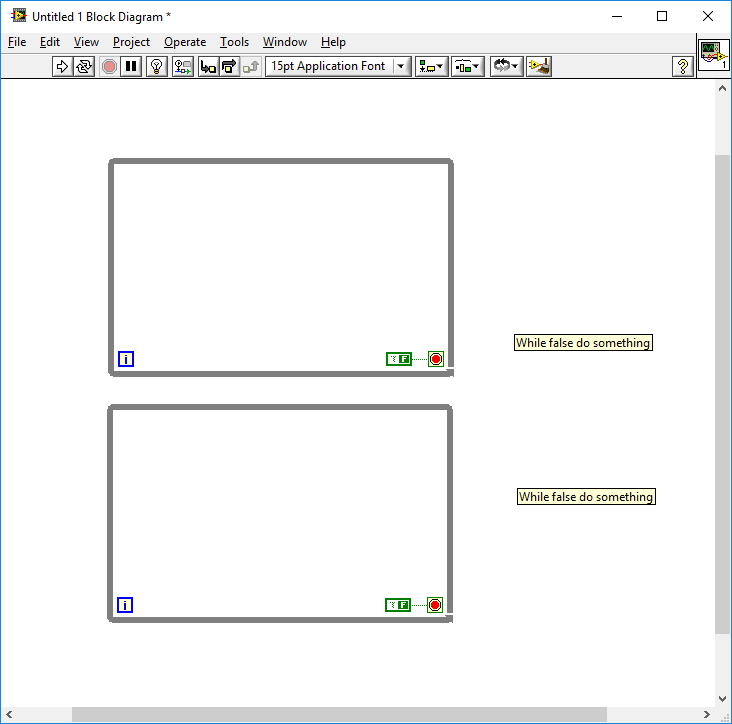-
Posts
4,987 -
Joined
-
Days Won
311
Content Type
Profiles
Forums
Downloads
Gallery
Everything posted by ShaunR
-

OpenG Read GIF File slow to execute?
ShaunR replied to Bas de Jong's topic in OpenG General Discussions
Well done for volunteering I look forward do testing it -

OpenG Read GIF File slow to execute?
ShaunR replied to Bas de Jong's topic in OpenG General Discussions
Nice. It's screaming out to be made into an xControl, IMO. -

boolean or Boolean? and other wiki style questions...
ShaunR replied to Aristos Queue's topic in Wiki Help
When the compiler doesn't care, why should I? The view I take is that "Style Guides" are just that. GUIDES, not LAWS. If "boolean" was chosen, what do you do about capitalisation at the beginning of a sentence? There are arguments for grammatical considerations but I'm "meh" when it comes to programming type names, classes at. al. These things are just a distraction - form over function. Read it and weep: -

boolean or Boolean? and other wiki style questions...
ShaunR replied to Aristos Queue's topic in Wiki Help
This is a historical "problem" due to compilers being case sensitive. This was one of the reasons that I went for Pascal compilers over C since Object/Open/Turbo Pascal is case insensitive and boolean or Boolean are synonymous (as a type). I've always maintained that there is no excuse for case sensitvity as it only introduces errors, obfusicates and increases foot-shooting but has zero benefits (unless you consider obfusication a benefit which is arguably a security risk). I've had many conversations with C/C++ programmers over capitalisation of types and function names (initial caps vs camel case vs lower case etc) and my response has always been "whatever". Do we really need to bring this problem to a wiki, of all things, about a language in which case is irrelevant? -
Transmittion of data at a rate (Hz) is not very conducive for ethernet. It is intended to move large amounts of data efficiently. Typically, ethernet connections use the nagle algorythm where data is transmitted after the accumulation of a certain number of bytes or after a timeout (typically 250ms). This is to solve the issue of small data packets flooding the connection (which is what happens at high rates with, say, a single double in the packet) If the nagle is turned off, then packet overhead comes into play and the network can start to behave irratically at high data rates. This is where ethercat comes into it's own. At least one week if you don't already have a solution in your toolkit.
-
One aspect of reflective memory architectures is determinism. For that reason and without a full detailed spec, I would err on a reflective memory network solution (option 1). You may have to start looking at ethercat and synchronising asynchronous systems depending on the reasoning for the insistance of the reflective memory in the first device since you get that for free with a reflective memory network.
-
I'd be interested to see a comparison with SQLite (Altenbach didn't post his code). Those times seem really slow for the number of entries.
-
xControls are at timestamp 1:01:51
-
In todays censorious climate (and YT copyright trolls). The trend seems to be to use Bitchute as an alternative backup.
-
As everyone else is suggesting. Simulators are non-trivial and product specific. You pretty much end up reverse engineering the software in the device you are simulating. One method I have used in the past though is message capture. This works with TCPIP, serial and other similar devices. Basically you capture/record the message strings for specific control messages and play them back to your software-usually used for testing. If your software architecture is message based, then it's trivial to switch out the endpoint just by redirecting to the comms interface instead of a play-back VI and you don't suffer from the "bug in simulator vs bug in device" problem.
-
That's unfortunate as I've just released one xControl and am about to release another
-
Nope. You may want to extend that courtesy but it isn't required for BSD.
-
-
The FP control is set to "Include Data Type" if the property node is "strict" and will be a boolean output from the property node. You will see a red cross in the bottom left corner of the control in this state. If "Include Data Type" is unchecked, there will be no cross and the output of the node will be a variant as no type information is defined for the control..
-
The software was never productionised and released due to lack of interest.
-
AQ has been looking into this for me offline (Thanks AQ) and managed to replicate the issue I was seeing. Addig a delay resolves the issue (which I plan to put in the known issues since it cannot be resolved internally in the xControl) AQs explanation of what is happening: He also said that the problem goes away if source code is separated from the VI (not available in 2009). So. I'll do some more testing and then release the xControl.
-
Error 2250 is the windows error code for "This network connection does not exist.". It seems consistent with what Rolf is saying about the function.
-

How do you organize important posts and code you read
ShaunR replied to 0_o's topic in LabVIEW General
I just post something along the lines of "can't find it right now" and usually someone with better organisation than me finds the link. Damn. giving away all my secrets. -
Well. I didn't even get one like, let alone 10 points
-
Apollo 13? (It's a NASA saying)








